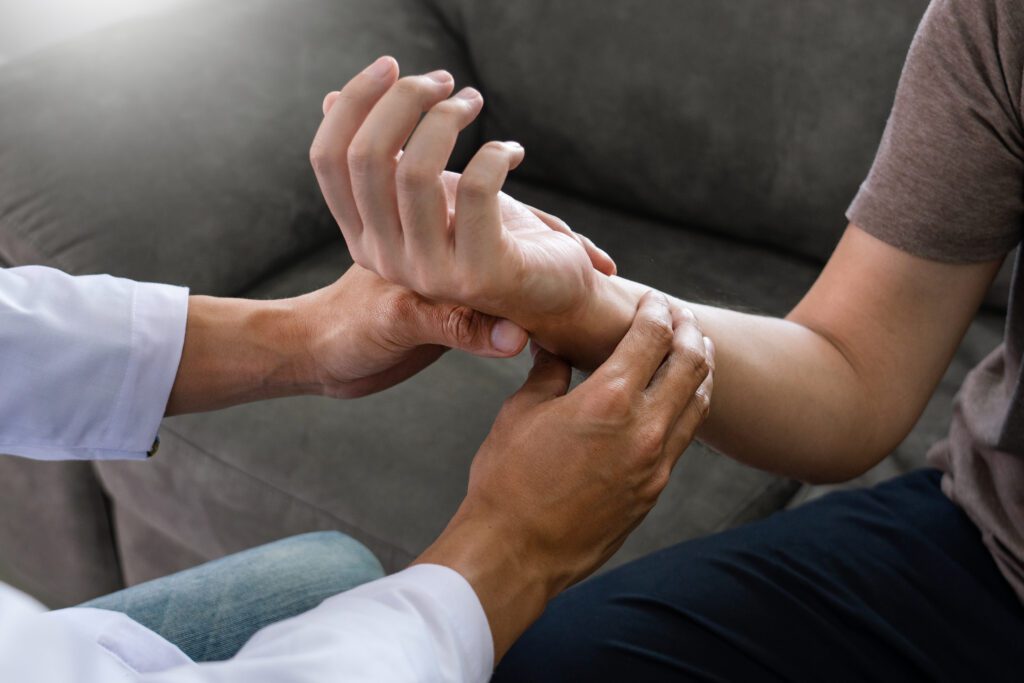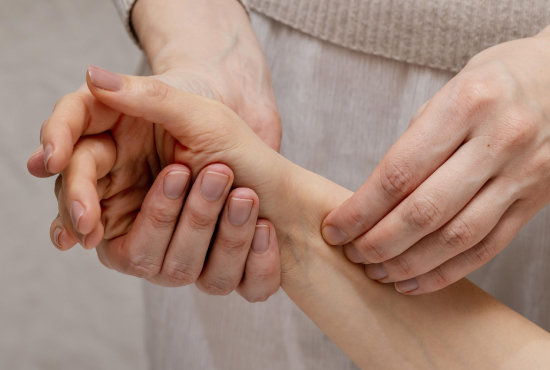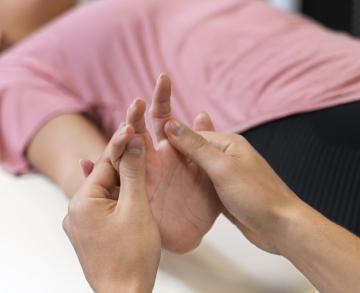Introduction to Hand and Finger Physiotherapy
Specialized Physiotherapy for Hand and Finger Conditions
Hand and finger conditions can drastically affect daily life, challenging even simple tasks. At Orthocure, we specialize in physiotherapy treatments for various hand and finger issues, from arthritis and trigger fingers to injuries like fractures and tendonitis. Our experienced physiotherapists employ a combination of manual therapy, tailored exercise programs, and innovative pain management strategies to reduce discomfort, increase mobility, and enhance overall hand function.

Understanding Hand and Finger Pain Challenges
Addressing the Complexities of Hand and Finger Disorders
Hand and finger disorders come in various forms, each presenting unique treatment challenges
Chronic inflammation causing pain and stiffness in joints.
A condition that causes pain and stiffness, with fingers catching or locking in a bent position.
Acute conditions needing targeted rehabilitation to restore function.
These are common when using their hands frequently and require specialized exercises to alleviate symptoms.

Benefits of Physiotherapy for Hand and Finger Pain
Transformative Effects of Physiotherapy on Hand and Finger Health
Physiotherapy offers numerous benefits for those suffering from hand and finger pain
Pain Reduction
Through various modalities designed to alleviate discomfort
Mobility Improvement
Exercises that enhance range of motion and flexibility.
Strength Building
Strengthening programs that improve hand grip and functionality.
Preventive Measures
Educating patients on preventing future injuries and managing chronic conditions effectively.
Types of Hand and Finger Conditions Treated
Comprehensive Treatment for Diverse Hand and Finger Ailments

Our physiotherapy services cater to a wide array of hand and finger conditions
Arthritis Management
Techniques to reduce joint pain and increase mobility.
Post-Surgical Rehabilitation
Ensuring a full recovery through guided exercise and therapy.
Injury Recovery
From sprains to complex fractures, restoring optimal hand function.
Chronic Pain Management
For conditions like rheumatoid arthritis, providing ongoing support and care.
The Orthocure Approach to Hand and Finger Physiotherapy
Our Proven Strategy for Optimal Hand and Finger Recovery
Thorough Diagnostic Assessment
Evaluating the specific causes of hand and finger pain.
Customized Treatment Plans
Tailored to individual needs, focusing on relieving pain and restoring function.
Advanced Treatment Techniques
Utilizing the latest physiotherapy research to provide adequate care.
Holistic Care and Support
Offering comprehensive solutions beyond symptom management to improve hand health.
Focus on Arthritis in Hands and Fingers
Effective Management of Arthritis in Hands and Fingers
Arthritis in the hands and fingers can be debilitating, affecting one’s ability to perform basic daily activities. Here’s how specialized physiotherapy can help manage this condition effectively
Detailed Evaluation
Understanding the extent of joint damage and functionality.
Pain Management Strategies
Techniques to reduce pain and inflammation.
Joint Protection Techniques
Teaching methods to reduce stress on joints during activities.
Therapeutic Exercises
Tailored exercises to maintain joint mobility and reduce stiffness.
Strength Training
Gentle manipulations to improve movement and reduce discomfort.
Ergonomic Advice
Suggestions for modifying daily activities to ease joint strain.
Heat and Cold Therapy
Applications that help reduce joint pain and inflammation.
Manual Therapy
Gentle manipulations to improve movement and reduce discomfort.
Education on Assistive Devices
Using tools that help reduce the joint burden.
Ongoing Monitoring and Adjustment
Adapting treatment plans as the condition progresses or improves.
FAQs on Hand and Finger Physiotherapy
Physiotherapy is highly beneficial for managing hand arthritis by reducing joint pain, increasing mobility, and improving strength. Therapists may employ manual therapy, therapeutic exercises, and modalities like heat or cold therapy to ease symptoms. Exercises typically focus on enhancing joint flexibility and building muscle around the joints to support and stabilize them, which can help decrease discomfort and increase hand function. Additionally, physiotherapists provide valuable advice on joint protection and ergonomic modifications to daily activities, which can significantly alleviate stress on arthritic joints.
Practical exercises for working the trigger finger focus on increasing the range of motion, reducing stiffness, and strengthening the finger muscles to prevent locking or catching. These exercises include finger lifts, stretches, and gentle gliding exercises that encourage the tendon to move smoothly through its sheath. A physiotherapist might also recommend specific exercises to reduce inflammation and incorporate splinting techniques to rest the finger at intervals. Consistent practice of these exercises can significantly improve symptoms and mobility for those suffering from trigger fingers.
Physiotherapy is crucial in the effective treatment of finger fractures. It helps restore mobility, strength, and function following the healing of the bone. Initially, therapy may focus on gentle mobility exercises to prevent stiffness, gradually progressing to strengthening exercises once the fracture has sufficiently healed. Soft tissue massage, joint mobilization, and ultrasound therapy enhance recovery and reduce pain. Physiotherapy not only speeds up the recovery process but also decreases the risk of developing long-term complications such as reduced function or chronic pain.
During your first physiotherapy session for hand pain, the therapist will conduct a comprehensive assessment, which includes taking a detailed history of your condition, performing a physical examination, and assessing your pain and functional capabilities. This initial evaluation helps to identify the underlying causes of your hand pain, whether it’s due to overuse, injury, or a chronic condition like arthritis. The physiotherapist will then discuss a personalized treatment plan that may include manual therapy, exercises, and modalities. You’ll also receive advice on avoiding activities and managing your pain at home.
Maintaining hand health after completing physiotherapy involves continuing with exercises and techniques learned during sessions. Regularly practising strength, flexibility, and mobility exercises can help keep the muscles and joints in good condition. It’s also essential to adhere to ergonomic advice, like using proper hand positions during activities and taking breaks during repetitive tasks to prevent strain. Applying heat or cold therapy, as your physiotherapist advises, can help manage any recurring pain or stiffness. Regular check-ups with a physiotherapist can also help monitor hand health and prevent the recurrence of issues.
For broken finger recovery, physiotherapy employs various strategies to reduce pain, restore mobility, and strengthen the finger once the bone has healed. Initially, therapy may include gentle passive movements to maintain joint mobility and prevent stiffness. As healing progresses, active exercises are introduced to increase the range of motion and strengthen the muscles around the finger. Manual therapy, ultrasound, and electrical stimulation facilitate healing and reduce pain. Additionally, functional exercises that mimic everyday activities are incorporated to ensure a total return to functionality.
Physiotherapy can effectively address many types of finger pain, whether they stem from injuries, overuse, arthritis, or post-surgical conditions. By employing a range of techniques, including manual therapy, exercise regimens, and modalities for pain management, physiotherapists can alleviate pain, enhance joint function, and improve strength and flexibility. However, the success of physiotherapy can depend on the specific cause and severity of the pain. Some conditions may require additional medical treatments alongside physiotherapy to achieve optimal outcomes.
Physiotherapy treats tendonitis in the hands and fingers by reducing inflammation, alleviating pain, and restoring function. Treatment often includes ice therapy, ultrasound, or soft tissue massage to decrease inflammation and pain. Specific stretching and strengthening exercises are tailored to relieve stress on the tendons and gradually rebuild strength. Physiotherapists also advise on activity modification and ergonomic adjustments to prevent further strain and promote the long-term health of the tendons.
Physiotherapy exercises for hand and finger arthritis are designed to reduce joint pain, improve mobility, increase strength, and enhance quality of life. Regularly performing tailored exercises helps to maintain joint function, reduce stiffness, and strengthen muscles around the joints, which can help support and stabilize them. These exercises often include range-of-motion exercises, gentle stretching, and strengthening activities. Physiotherapists also educate patients on joint protection techniques and adaptive devices to ease the burden on arthritic joints.
Physiotherapy is highly effective for post-surgical rehabilitation of the hands and fingers, playing a crucial role in helping patients regain function and minimize pain. After surgery, physiotherapy aims to reduce swelling, prevent stiffness, and start gentle mobilization. Progressively, the treatment focuses on strengthening and functional exercises tailored to the patient’s specific surgical outcome and lifestyle needs. This comprehensive approach ensures optimal recovery and can significantly shorten the recovery time while improving the overall outcomes of surgical interventions.
A physiotherapist should guide the frequency of physio exercises for finger injuries based on the specific injury and individual healing progress. Light exercises are recommended several times daily to keep the joints mobile and prevent stiffness without exacerbating pain. As recovery progresses, the intensity and frequency of the exercises may be adjusted. It is essential to follow the tailored advice of your physiotherapist to ensure exercises are performed safely and effectively, promoting healing and preventing further injury.
Yes, physiotherapy is very effective in helping with finger stiffness after an injury. Treatment may involve manual therapy techniques such as joint mobilizations and soft tissue work to improve movement and reduce stiffness. Exercises tailored to extend the range of motion and strengthen the muscles around the finger are also crucial. Heat therapy may be incorporated to relax and loosen stiff muscles and joints. Physiotherapy can significantly enhance finger mobility and function by addressing both the symptoms and underlying causes of stiffness.

